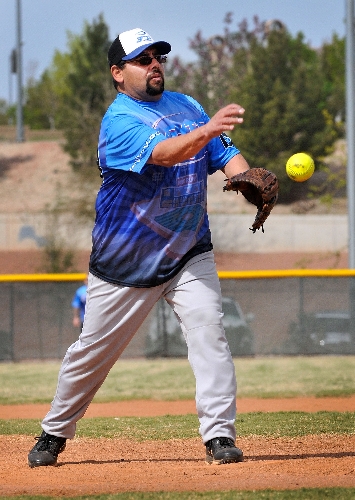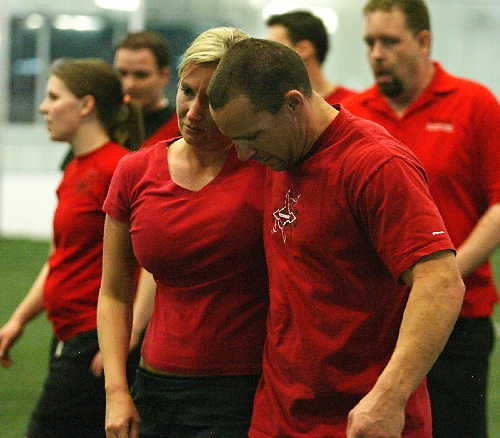Some recreational athletes willingly risk injury for their sport
Off the ball field, Sergio Hernandez is a genial guy who talks a blue streak and makes friends like he's a politician campaigning for election.
But when he steps onto the pitcher's mound, he slips into his ballplayer persona, a pitching machine, fearless and focused. Hernandez plays to win. And he has the scars to show for it.
That twisted looking fingertip on his right hand? Broke it fielding a ball. That occasional hitch in his gait isn't from a pebble stuck in his shoe; it's a limp from breaking his right ankle sliding into second base 20 years ago.
Risking and sustaining injuries during a game comes with the title of professional athlete.
But Hernandez, 44, works in the shipping and receiving department of a local casino. The ball he plays? Recreational slow-pitch softball. Coed, in fact. Still, to Hernandez, that's no excuse to play like winning isn't important. Much like his fellow War Pig teammates, Hernandez is a competitive guy, so when he steps onto the field, it's on. And that means no holding back.
Millions of Americans play recreational team sports, putting themselves at risk of injury and, in some cases, even death. Seven million sports and recreation-related injuries occur each year, according to statistics from the Centers for Disease Control. The overall economic impact of these injuries hasn't been calculated, but it can cost an individual thousands of dollars depending on their insurance coverage, type of injury and whether it interferes with work.
Knowing this, why do some average people play like they get paid to do it?
"I love the sport. It's competitive, fun," says Hernandez, who started playing softball at 18. Now, he plays three to five days a week. "To me, it eases my mind."
The idea that he could be injured doing something he enjoyed never occurred to Hernandez, until he slid into second and fractured his ankle. At the time, his insurance covered the treatment costs and the doctor put a walking cast on his foot, so he was able to work. But when he broke his fingertip a year later, he didn't have insurance.
"I just went to the drugstore and got a splint," he says. "The finger looks kind of weird now."
His teammate, Jeff Robinson, 31, can relate. After sliding into bases every Friday night for the past six years, Robinson's knee has built up so much scar tissue that it has developed a purplish, new-skin look to it. In a seven-week season, there might be one week when he doesn't sustain a bloody knee.
"I've dove for the ball, I'll throw myself on the ground for a play. It doesn't matter," says Robinson, a location manager for Hertz. "It's kind of instinct. You deal with the consequences later."
Such a competitive attitude might seem macho and testosterone-driven but it certainly isn't unique to men. Robinson and Hernandez say their female teammates want to win as badly as they do. They've seen women sprain their ankles, jam fingers, even get hit in the face by a ball that took a funny bounce. And they keep coming back for more.
Mary Hildebrandt, 31, says she likes the camaraderie that comes from being on a team. She also likes the calorie-burning effects of chasing a soccer ball or going deep for a pass from the quarterback. One of her main goals of playing? Winning.
"That's why you kind of play, to be a champion," Hildebrandt says. Currently, she plays coed indoor soccer, kickball and full-contact women's football.
The risk of injury comes with the territory, says Hildebrandt, who tore a knee ligament while running high school track. During soccer, people throw elbows, knock others against the wall, trip or even kick people. It's all legal, though. In football, she plays wide receiver and is always vulnerable to injury when she catches the ball.
Sometimes, her knee gives out on her and she feels the aches and pains of taking full body contact during football. That's not stopping her from playing, though.
"I figure I could get hurt anywhere so I'd rather be doing what I want. I know I'm one day headed for knee surgery, but I'm hoping by that time the recovery is quicker," she says.
There's a fine line between playing your heart out and playing as if you're out of your mind, though. Hildebrandt's boyfriend Jimmy Lavorci, 36, used to ride professional motocross. He knows what it's like to push yourself as far as possible during a competition; it eventually becomes second nature. A broken collarbone and femur are just two injuries he sustained while riding. Now that he plays indoor soccer, kickball and softball for fun, he tempers that urge to push his limits with a healthy dose of reality and one question: Will it keep him from being able to work?
"That will help decide whether I do something stupid or not," he jokes. "I usually don't do something where I push myself too far. But anything can happen, I just try not to think about it."
A bloody knee is the worst injury Robinson has ever had. He says he isn't concerned about arthritis or other cumulative effects of trauma.
"I think it's part of life. What am I saving my body for?" Robinson says. "I don't think I'm destroying my body."
Still, he has a couple of ongoing nagging injuries that occasionally bother him. Aches and pains.
Perhaps part of being competitive in team sports is the ability to get knocked flat on your back and then get up and say, "That didn't hurt." Indeed, Robinson, Hernandez and even Hildebrandt exhibit a casual, "yeah, stuff hurts, so what?" attitude about their athletic endeavors.
There is one thing that shows a tiny dent in that tough-guy armor, and Robinson freely admits to it:
"One thing I have noticed as I've gotten older is that now, everyone rolls out to the field with ibuprofen," Robinson says.
Contact reporter Sonya Padgett at spadgett@ reviewjournal.com or 702-380-4564.



















